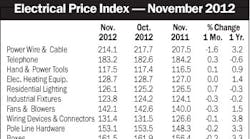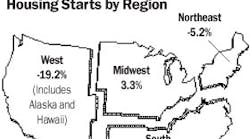Latest from Mag
People - Dec 21, 2012
Obituaries - Dec 21, 2012
November EPI Index Shows No Change
Housing Starts Dip 4% in November
Electrical Marketing - December 21, 2012
Around the Industry - Dec 21, 2012
Your new 20-something salesperson doesn’t enjoy the after-hours schmoozing with customers that was always such a big part of sales. That bright new hire in the marketing department whom you thought would be part of your team for years gives notice after just nine months on the job.
Unusual? No. According to several experts on the changing demographics of the work force, lack of company loyalty and an aversion to old-time pressing the flesh are two of the defining traits of the "buster generation" (born 1969 to 1978) and "netster generation," (born 1979 to 1988).
At the annual meeting of the National Association of Wholesaler-Distributors, Washington, D.C., held Jan. 31-Feb. 2, Marilyn Moats Kennedy, founder and managing partner, Career Strategies, Wilmette, Ill., said distributors need to realize that the while the younger generation enjoys socializing with peers their own age, an age barrier can exist between them and boomers (born 1946 to 1959). Kennedy said some universities have identified this problem are trying to teach students how to make small talk with their elders. She says this communications disconnect will affect how baby boomers train the younger generation to be salespeople. "You have to script netsters ruthlessly for sales," she said.
Kennedy also warned NAW members (who are mostly ‘pre-boomers’ born 1934 to 1945 or baby boomers) that busters and netsters don’t place the same importance as baby boomers on job longevity, retirement benefits and team play. Instead, she said they’re motivated by a flexible work environment and time off.
"One size does not fit all, so it’s best to vary the rewards system," she said. "pre-boomers’ (born 1934 to 1945) and baby boomers are motivated by money and the younger groups of employees by time off. Why not offer what each group wants most? Investigate buy-back plans in which employees can buy additional vacation time. Mentoring is also an important perk."
Another speaker at the NAW meeting, Dr. Stephen Happel, an economics professor at Arizona State University, believes members of the generation born after 1983, sometimes called "Generation Y" or the "millennial generation," show an early propensity to spend much of what they make, a trait he says will drive sales for boomers’ companies and help fuel the U.S. economy. "The consumption demographics couldn’t be much better with Generation Y and the millennials," he said. "Seventy percent of the gross domestic product is consumption spending."
The younger generation will grow up in a very different distribution world because of the wave of mergers and acquisitions sweeping not only the electrical market, but many other distribution-based lines of trade in the construction, industrial, retail and consumer markets. In his presentation, "Financial investment in wholesale: A green light in 2006," James Miller, managing director and principal, Brown Gibbons Lang and Co., Cleveland, offered distributors an investment banker’s perspective of how private-equity firms analyze prospective acquisition candidates and an overview of the level of acquisition activity.
Miller said in 2004 more than 80 financial buyer were actively evaluating acquisition opportunities in the wholesale-distribution world, compared to less than three dozen who had interest in 1999. In 2005, these private-equity firms had raised more than $170 billion in buy-out funds, compared with $42.2 billion in 2004 -- a 300 percent increase. Miller said more than 150 of these firms had at least $1 billion in funds in their war chests. Many of these firms are putting these funds to work, he said, as financial buyers have reported acquisitions of 35 distributors in 2005. Those acquisitions had cumulative sales of more than $38 billion. In contrast, only three distributors were bought by financial buyers in 2000, he said.
Meeting attendees were glad to hear from several speakers that 2006 should be a good year for the distribution industry. Arizona State’s Happel said the western states will continue to lead the United States in growth. Nine of the 10 leaders in percent increase in GDP from October 2004 to October 2005 were in the western U.S. (only Florida was not in the region).
Secretary of the Treasury John Snow, who was on hand at the NAW annual conference to accept NAW’s Distinguished Leadership Award from NAW President Dirk Van Dongen, was also bullish on the U.S. economy. He said a key reason for the economic growth of the past few years was the lower tax rate engineered by the Bush Administration.

